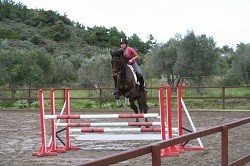The Medieval City of Rhodes.
The Medieval City is located in the center of the island. It is a destination recognized by UNESCO as one of the best-preserved medieval cities in Europe. Some important monuments are the palace of the Grand Master, the mosque of Suleiman, the Muslim library, the Medieval Moat, the archaeological museum. Most are accessible by electric scooter.
Monte Smith Hill.
Just outside of Rhodes is the small mountain of Monte Smith where there is the Temple of Apollo and the Ancient Stadium, they have a history of 2000 years. At the point of the temple extension you can see the northwest side of the island. It is an accessible and well-known route Beaches with See track The four points where the sea access system exists are the beaches,
The basis of Rhodesian cuisine is wheat and olives. You will have the opportunity to try delicious dishes based on meat, fresh fish and seafood, salads, a wide variety of sweets and desserts made from cereals, olive oil, nuts, fruits, honey and herbs, make up the unique Rhodes cuisine. Particularly widespread on the island are wheat porridge, pasta such as trachanas, macaroni, noodles and greens such as capers, wild greens, burdock root, vine leaves, red pumpkins, onions, beans and many others that are used in many traditional recipes.
Traditional dishes
From the appetizers, try the Rhodesian pitaroudi (chickpea meatballs with plenty of chopped mint, onions and a tomato), pumpkin meatballs, mefake dolmades in cyclamen leaves. From the main courses, try vlitas and yachni sliders, stuffed (from tomatoes and peppers and pumpkin flowers or onions), oven-baked pumpkin, red mullet beans with tomato and pepper, carabolos (snails fried with plenty of onions and cumin or with semolina), entreda with meat and vegetables, goat in pydiako, chicken with pelgouri, spetzofai and chicken with loukumi (a type of pasta), lopi (goat meat with lopi i.e. dry beans or chickpeas). a special dish is amarangi, i.e. the sprouts of the May daisies, which are eaten boiled with vinegar, accompanied by garlic. Also, the Rhodesian cuisine does not lack fine cheeses (hard, soft and semi-hard), produced mainly in mountain villages. “Camels”, cyclamen as they are called in Rhodes, have a special place in the local gastronomy. The tender leaves from the cyclamen after being scalded, just like the vine leaves, are filled with rice and poured with eggnog, the bulbs of the cyclamen are cleaned of the outer skin and scraped like quince, they become bitter after simmering with plenty of sugar and grated nutmeg and are eaten as a dessert spoon!
Pomegranate sweets
The traditional sweet of the Rodites for all joyful events, is the melekouni. It has a soft texture with an aroma of orange peel, cinnamon and nutmeg. Mantinades (a kind of small dry pan), musk pouches, tahino pies, apricot paste. During your stay on the island, don’t forget to drink the Rhodes suma. It is produced in the village of Embonas at the end of September.
Ancient history
Rhodes has been inhabited since the Stone Age. In prehistoric times the island was inhabited by the Cretans, the Phoenicians and the Dorians. After the Trojan War begins the rapid progress and development of the ancient culture of Rhodes and writers. From 200 BC Rhodes became an ally of Rome and was bound to have the same friends and enemies as the Romans, but from the 1st century BC. slowly began to decline.
Byzantine period until modern history
After the division of the Roman state, at the beginning of the 4th century, Rhodes entered the Byzantine Empire. In 515 AD the city of Rhodes was destroyed by an earthquake and rebuilt by the emperor Anastasius. During the Persian wars it was occupied by the Persians (620 AD).
In the 9th century it suffered greatly at the hands of the Seljuks of Harun al-Rashid who plundered the island barbarously (807 AD). In the 11th century, the revival of former commercial activity began and Rhodes established trade relations with the West with the Crusaders, to whom Rhodes supplied ships and mercenaries.
Rhodes hosts dozens of endemic species of flora and many rare animals. The largest island of the Dodecanese has an area of 1,398 sq.km. and a coastline that reaches 220 km. Rhodes is full of small rivers, streams and torrents, the most important of which are the Valley of the Butterflies, the Seven Springs, the Asklipinos, the Loutanis, the Gadouras, the Pelekanos, the Sianitis, the Chirenes, the Pelemonis, Makaris, Skolonitis, Meridiatis, Skodouliaris and Argyros. In the center of the island, the beautiful artificial lake of Gadoura has been created, while a little further southwest is the smaller artificial lake of Apolakkia. On the island there are also remarkable canyons, such as Kontari, Kopria and Xetryptis. Rhodes is famous for the rarity of its plants. on the island there are more than 1. 400 plant species of which 26 are endemic and can only be found there. In the past, the island was covered by dense pine forests which gradually shrank due to fires. Today the vegetation in the mountains consists of rough pines and cypresses in their wild form. Other trees are sycamores, sea buckthorns, maples, holly trees, arias, sycamores, wild olives, gorse trees, and gorse trees. The presence of the beautiful beggar tree (Liquidambar orientalis), an Asian tree that is only found here in Europe, stands out. Plant lovers come to meet the emblematic endemic species of Rhodes, such as the fritillaria, the cyclamen, the sylene, the daisy, the bellflower, the peony,
Medieval City
The Grand Master’s palace which also functions as a Byzantine Museum. Opposite the palace and among relics of various historical periods, there are the ruins of the Catholic Church of Saint John.
The Grand Master’s palace was built on the site of the lower Acropolis of ancient Rhodes, where the temple of the Sun God was originally located. In the same position on the 7thThecentury there was a Byzantine palace and then in the 14Thecentury, the knights of Agios Ioannis built the palace as the residence of the Grand Master and as the administrative center of the city. It was destroyed in 1856 by a large explosion of gunpowder that was hidden in the basement of the church of Agios Ioannis.
The Grand Master’s palace was rebuilt according to its original plans by the Italians in 1940.
- The Archaeological Museum of Rhodes
The building of the Hospital of the Knights began to be built in 1440 and was completed by the Grand Master d’Aubusson (1476 – 1503).
This bioclimatically designed building houses the Archaeological Museum of Rhodes, which exhibits archaeological finds from various parts of Rhodes and the surrounding islands.
The original core of the building was built in the 11th century AD. After the occupation of Rhodes by the Knights of St John, between the years 1319 and 1334, the Byzantine church was converted into a Gothic basilica, while during the Turkish occupation the temple was converted into a Muslim mosque (Enterum Mosque).
The Jewelry Collection includes objects from the Ethnographic Collection of Italians, from the Folklore Archive of the Dodecanese and from donations, excavations and seizures of the Archaeological Service of the Dodecanese. It is an expression of the elegance of the inhabitants of the islands in recent times.
The Collection includes clothing, embroideries, woodcarvings and metalwork and ceramics. Among them are samples of Nicaea pottery (16th to 19th century), plates from Armenian houses of Kyutachia, jugs with plastic anthropomorphic or monstrous decoration, samples of local pottery from Rhodes villages and ceramics of European origin from the 19th and 20th centuries as well as woodcarved objects .
The traditional women’s clothing of Symi, Astypalaia, Embona Rhodes, Karpathos, Nisyros, Tilos and Halki occupy an important place among the exhibits.
It includes collections of paintings and engravings that fully represent 20th century Greek art and its distinguished artists, many sculptures, drawings and documents. . It includes the organization of exhibitions of modern Greek art of the 20th century with a pan-Hellenic or international scope, visual interventions of a pioneering nature, exhibitions of prominent Greek and foreign artists, historical documents and others and exhibitions of visual artists of Dodecanese origin
. It was built by the Italians in the year 1934. In 1937 it began to operate as a research unit under the name Royal Institute of Marine Biology of Rodi (Reale Instituto di RicercheBiologiche di Rodi). From 1947, after the integration of the Dodecanese in Greece, it operated under the supervision of the Academy of Athens as a Hydrobiological Institute. Since 1963 it has been operating as an aquarium and museum under the name Hydrobiological Station of Rhodes and as a research unit in the Mediterranean.
Saint Catherine’s Guest House is located in Burgos, the Medieval City of Rhodes. It was built in 1391-92, under Grand Master Heredia, by the Italian Domenico d’Allemagna, Admiral of the Order of the Knights of St. John. In the founding contract of the Inn in 1391, it is stated that it was founded in the borough of Rhodes, near the walls at the gate that led to the pier and already in 1465 it was called the gate of AgiaEkaterini.. The inn of AgiaEkaterini operates an exhibition space where the restoration work is exhibited building, a representation of a bedroom from the Knights era and antiquities found in the surrounding area.
The Jewish Museum of Rhodes began in 1997. The inspiration behind the idea of creating the Museum and its founder is Aron Hasson. So as a first step in October 1997, with his own initiative and funding, an exhibition with photographic material opened its doors in the area next to the Synagogue where the womanizer used to be.
At the same time he founded the Rhodes Historical Foundation, a non-profit organization used as a vehicle to promote this goal and began collecting photographic, historical material and artifacts from Rhodes from Rhodesians abroad and from various other sources around the world. as well as donations to further the cause.
The unique Museum of Beekeeping and Natural History in Greece gives its visitors the opportunity to live unique experiences and get to know the wonderful world of bees in the transparent observation hives, the tradition and history of Beekeeping in Rhodes and the honey processing process
Representation of the traditional Rhodesian house. Every year, on June 23, the revival of Klidon takes place in its premises.
The traditional settlement of Koskinou consists of houses with colorful facades, beautiful courtyards with the typical Rhodian shack and its traditional interior decoration with ceramic plates and woven walls. It is located in the village of Koskinou. The preserved traditional house in the center of the village of Koskinos revives the tradition, art and nobility of the people of the village. The interior decoration with ceramic plates and wall hangings enchants visitors.
It hosts minerals and fossils from Greece and around the world such as the minerals of Lavrio and many copper and lead minerals, rocks, fossilized tree trunks and fossilized plants. Organisms from earlier times and fossil marine organisms are in separate showcases.
Artistic Village Contemporary Art is an art gallery and Museum of Ceramic Art and has been operating since 1984, created by Nikolas I. Symiakos. In the welcoming exhibition space with an area of 600 m2, visitors can find innovative works of art, decorations, sculptures, special constructions and compositions, made of clay, glass, wood, bronze, iron, aluminum and other materials. The Artistic Village also includes a painting room, a 200 sq.m. workshop. and an open Museum of Ceramic Art.
The Museum is an open exhibition space located in the Artistic Village. It is the first and only museum where visitors can experience a journey into the past and experience the art of clay from the beginning to the present day. At the Museum of Ceramic Art, visitors can first see the workshop, where inside is the space where the craftsman works
The park of Rodiniou is located three kilometers from the city of Rhodes, along the avenue of Rhodes – Lindos. It is the oldest park in the world and is distinguished by its dense and diverse vegetation. Small bridges, water lily-filled ponds and wonderful paths make up the idyllic landscape complemented by rare plants and a small zoo. The peacocks hosted by the garden move freely in the park attracting her
It is located in the settlement of the village of Psinthos.
. In the village of Kalythion there is the intersection that leads to the village of Psinthos and PigiFasouli. There one can enjoy a natural environment around the stream with rich hydrophilic vegetation of tall plane trees (platanus orientalis) and myrtus (myrtus communis). world, little fish Gizani.
It is a rare habitat that hosts the PanaxiaQuadripunctaria butterfly that makes its appearance in this unique natural park from mid-June to mid-September.
It is twenty-five kilometers from the city of Rhodes. The Museum of Natural History of Rhodes operates at the entrance of the museum. The exhibits of the museum are presented in showcases that represent the conditions of the natural environment according to the most modern museological concepts. The exhibits include endemic and rare species of the wider area of the Valley. It also operates a hatchery-exhibition of butterflies with live exhibits, a library and a modern conceptual and botanical laboratory.
It sits at an altitude of seven hundred meters and takes its name from the Monastery of Prophet Ilias.
When the Italians occupied the Dodecanese on May 5, 1912, they began the reconstruction of the island. Thus, in the 1930s, they created the village of Campo Ciaro and the two enchanting hotels Elafos in 1929 and Elafina in 1932 or Cervo e Cerna in Italian with West Tyrolean chalet-style architecture in Eleusa. These hotels were improved in 1950.
The area of the Prophet Elias was full of forests where thousands of deer live.
They are located at a distance of nineteen kilometers southeast of the city of Rhodes and very close to the village of Archangelos. It is a wonderful location with many pines and plane trees. In the area there is a lake consisting of seven springs where one can see geese, ducks and peacocks. The temperature in the area is low. Their water is channeled into the plain and irrigates the fields of Kolymbia. It is worth visiting the tunnel that was built for the old Italian aqueduct that ends in an artificial lake with cold water.
The Apollakia Dam with its artificial lake is a beautiful wetland, unique on the island. The environmental value of the lake resulting from its special flora and fauna has included it in the Natura 2000 network as a protected area.
Prasonisi is located in the southernmost part of the island, ninety kilometers from the city of Rhodes. A small peninsula in the summer and an island in the winter, it is a paradise for surfers. On the surfers’ side there are places to rent surfing equipment. The five hundred meter strip that connects Prasonisi with Rhodes is suitable for moments of relaxation.
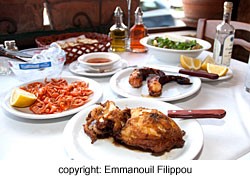
Most of the traditional recipes of Rhodes have their roots in Doric Rhodes, the time when cereals had a special place in the diet of the Rhodians. Athenaeus in his work “Dipnosophistai” mentions that the Rhodians brought purchased bread at the beginning of the dinner, among them “escharitis”, a sweet made with oil, something like today’s pancakes with honey and “Atavyritis”. In ancient Rhodes they especially loved fish soup.
Some of the food habits of Rhodes can also be found in many areas of the Mediterranean, such as Asia Minor and Southern Italy, which testifies to the ancient kinship ties and contacts that Rhodes had with these countries. Some of these foods have an initiatory or religious character, such as the foods and sweets that accompany engagements, weddings, baptisms and religious holidays such as Easter, Christmas and August 15th.
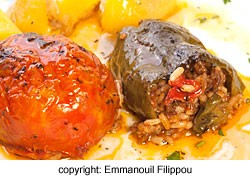
Given that Rhodes has always been a crossroads of cultures, the taste and diet draws elements from Asia, Europe and Africa. The basis of Rhodesian cuisine has always been wheat and olives, while most foods include elements of the Rhodesian land, the island’s livestock and fishing. Today Rhodesian cooking is based on delicacies from the sea, on original salads created from new horticultural products such as arugula, avocado and tarragon grown on the island and on meats cooked with new modern recipes.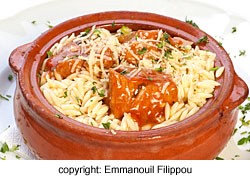

The park of Rodiniou is located three kilometers from the city of Rhodes, along the avenue of Rhodes – Lindos. It is the oldest park in the world and is distinguished by its dense and diverse vegetation. Small bridges, water lily-filled ponds and wonderful paths make up the idyllic landscape complemented by rare plants and a small
zoo. The peacocks housed in the garden move freely in the park attracting her
It is located in the settlement of the village of Psinthos.
In the village of Kalythion there is the intersection that leads to the village of Psinthos and PigiFasouli. There one can enjoy a natural environment around the stream with rich hydrophilic vegetation of tall plane trees (platanus orientalis) and myrtus (myrtus communis). world, little fish Gizani.

It is a rare habitat that hosts the PanaxiaQuadripunctaria butterfly that makes its appearance in this unique natural park from mid-June to mid-September.
It is twenty-five kilometers from the city of Rhodes. The Museum of Natural History of Rhodes operates at the entrance of the museum. The exhibits of the museum are presented in showcases that represent the conditions of the natural environment according to the most modern museological concepts. The exhibits include endemic and rare species of the wider area of the Valley. It also operates a hatchery-exhibition of butterflies with live exhibits, a library and a modern conceptual and botanical laboratory.

It is located at an altitude of seven hundred meters and takes its name from the Monastery of Prophet Ilias.
When the Italians occupied the Dodecanese on May 5, 1912, they began the reconstruction of the island. Thus, in the 1930s, they created the village of Campo Ciaro and the two enchanting hotels Elafos in 1929 and Elafina in 1932 or Cervo e Cerna in Italian with West Tyrolean chalet-style architecture in Eleusa. These hotels were improved in 1950.
The area of the Prophet Elias was full of forests where thousands of deer live.

They are located at a distance of nineteen kilometers southeast of the city of Rhodes and very close to the village of Archangelos. It is a wonderful location with many pines and plane trees. In the area there is a lake consisting of seven springs where one can see geese, ducks and peacocks. The temperature in the area is low. Their water is channeled into the plain and irrigates the fields of Kolymbia. It is worth visiting the tunnel that was built for the old Italian aqueduct that ends in an artificial lake with cold water.

The Apollakia Dam with its artificial lake is a beautiful wetland, unique on the island. The environmental value of the lake resulting from its special flora and fauna has included it in the Natura 2000 network as a protected area.

Prasonisi is located in the southernmost part of the island, ninety kilometers from the city of Rhodes. A small peninsula in the summer and an island in the winter, it is a paradise for surfers. On the surfers’ side there are places to rent surfing equipment. The five hundred meter strip that connects Prasonisi with Rhodes is suitable for moments of relaxation.

The route is of little difficulty. The path is built and starts from a steep face of rocks that you see. It passes over the village of Salakos at an altitude of 220 meters. There are the source “Nymph”. The path ends at the Monastery of Prophet Ilias at an altitude of 610 meters.
The route is 650 meters long. Around dense vegetation and we find 115 species of plants of which 20 are rare. We will see menexes and orchids as well as the rare endemic wild flower peony. Here you can also meet the Rhodes deer of the Platoni family and the Petritis falcon. The area is a wildlife sanctuary and belongs to the Natura 2000 network.

Taking the western road axis is the Valley of Butterflies. The route starts from the northern entrance of the Valley. The path is 1,300 meters long and ends at the Holy Monastery of Panagia tis Kalopetra at an altitude of 470 meters.
.It is a comfortable route. It hosts the well-known butterflies of Rhodes (Panaxiaquadipunctaria) during the summer, from the beginning of June to the end of September. In the Valley of Butterflies there is also the only natural forest in Europe made of a type of sycamore called Ygrambari (Zidia). The trail has an entrance fee which includes the visit to the Natural History Museum
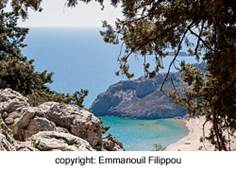
From the eastern road, a 1,200-meter-long winding asphalted road begins. From there, a serpentine path consisting of 297 steps leads to the top of the steep slope.
Passing through a forest of cypress trees with a few pines on the rocky ground, we reach the top where the chapel of Panagia Tsampika is located at an altitude of 320 meters. The returnismadefollowing the sameroute.
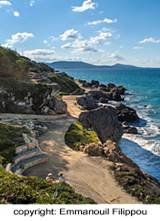
The path starts from the southern end of Psaropoula beach and ends at the northern end of the bay of Ialyssos.
At a distance of 300 meters, the path begins, with small stones in some parts of it. It is approximately 1,800 meters long and 2.5 meters wide. The path is organized, with elegant stone retaining walls and wooden railings that protect the walker from any danger. It is of little difficulty and one returns either from the same route or from the main road axis.

It is a demanding route because it takes place in a large altitude difference (750 meters). It starts from the south of the village of Embonas. There are two alternative routes:
One, the westernmost, is the smoothest but has no markings. Going uphill we end up at the ruins of the Temple of Zeus also known as Atavyrios Zeus, on the side of the highest peak which is not accessible.
The second route starts at the end of the dirt road then ends in a smooth little valley below the summit.
It is possible to climb from the northern edge of the village of Agios Isidoros with a marked path that goes out to the wind turbines and continues as above. There is no fountain or spring for water supply. The soil physiology is mainly stony and clayey.
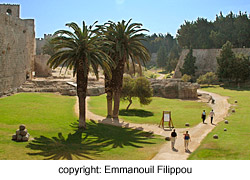
At the end of the 7th century AD the ancient city of Rhodes shrinks due to the ravages of the Arab raids. The Medieval City that is formed and fortified gradually takes its current form with the Moat in the 16th century AD. The total length of the Medieval Moat is 2,300 meters long and in several places its width reaches 70 meters. Entry to the public is free every day, 24 hours a day and at all times of the year.
The entry-exit points of the route are:
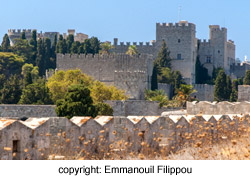
The route on the walls of the Medieval City is 1,100 meters long. It starts from the Gate of the Canons and ends at the Gate of Agios Ioannis or Gate of the Sieve. It is a special route, it has been declared by UNESCO as a World Cultural Heritage City, it inspires sanctity as thousands of young people fell in the small and large sieges of Rhodes by painting the walls with their blood. The entrance fee and the opening hours are determined by the Archaeological Service according to the needs of each period.
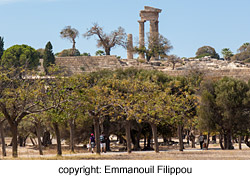
In the area of the Ancient Acropolis of Rhodes where the Temple of Apollo, the Ancient Theater and the Ancient Stadium are located, there is also a rich grove of myrtles, laurels, oaks, pines and cypresses.

This route starts at the foot of Filerimos hill. The foot is reached by walking a distance of 1,500 meters through the village. There is a water tap there. We meet oaks and sage trees to end up after 2,000 meters at the chapels of Prophet Elias the New and Prophet Elias the Old…

From this point, access continues only on foot for 500 meters., climbing 33 wide stone steps, we reach the Acropolis of Ialyssos and the Holy Monastery of Panagia tou Filerimos. A little further, about 100 meters and going down 5 steps, is the small church of Agios Georgios Hostos. Passing by the Golgotha pine tree with the 14 stone representations that correspond to the stops that the Lord made while ascending the road of martyrdom, we arrive at a plateau where the Cross rises majestically. It was rebuilt in 1996 and is 17.80 meters high. It has 66 steps inside. It can serve 25 guests at the same time.
In the wider area there are many peacocks.. At the end of January to the beginning of March one can find the wild cyclamen that grows in the area. The descent is made by the same route. It is of mild difficulty and the altitude is 247 meters.

The Springs of Kallithea are located nine kilometers northeast of the city of Rhodes and three kilometers before the tourist resort of Faliraki.
Their medicinal effect was already known since ancient times and the years of the Knights. In the area there is a pine forest with paths and streets that are suitable for walks. Its perfectly organized facilities occasionally host exhibitions and cultural events. Ithascoffee, snacks and a beautifulbeach.

Two to three kilometers before the church of Agios Nektarios are the Seven Springs. It is a magical location with centuries-old plane trees and running water.. Near the river with the crystal clear waters of the seven inexhaustible springs there are dirt paths that are offered for walks.

In the south of the island near the village of Apolakkia stretches the bay of Apolakkia. It is a Natura 2000 protected area due to the ecosystem, the sand dunes, a bushy Agrocedar called Arkethos and the Kareta-Kareta turtle that lays its eggs in the area. In the autumn season the beach is covered with hugs of white sea lilies.
Sports tourism Rhodes
The island is ideal for lovers of sports tourism as it is an ideal destination for mountain water sports and not only as it has modern facilities that can meet the requirements of the most demanding tourist. Many important sporting events take place on the island, where professional and non-professional athletes from many parts of the world participate. Young and old You have the opportunity to learn any sport you like. We organize activities with special equipment where the best trainers are needed.
Golf
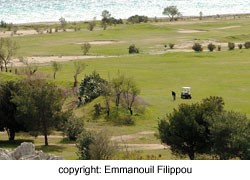
The Golf facility is located in the Afantou area, on the eastern side of the island. The course is 18 holes, PAR 74, 6,210 km long (Championships tees), 6 PAR 5, 4 PAR 3 and features:
Cycling
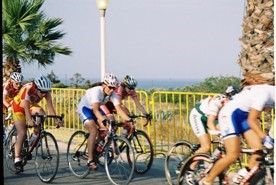
For road cycling there are ideal routes in the southern part of the island. They have well-paved routes with a wide variety of gradients.
One of them is of Agios Soulas in the village of Soroni of the Municipal Unit of Kameiros, on the eastern side of the island, 30 kilometers from the city of Rhodes. The routes are suitable for people with visual and reduced mobility
Rowing – Kayaking
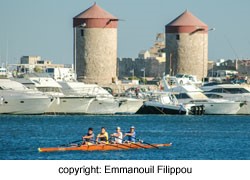
Rowing and Kayaking can be enjoyed in the sea area of the city of Rhodes and in the lake of Appollakia which is 1,750 meters long and 200 meters wide.. There is a provision for the formation of a facility at the Gadouras dam, which will be 5 kilometers long and 3 kilometers wide .For rowing and canoeing, Kayaking is carried out in collaboration with the Nautical Group, the facilities provide
Beach Volleyball and Volleyball
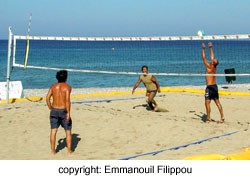
Favorite summer sport when we are near the sea. For Volleyball, they were built in 2007. There are two courts of international standards with modern competition and training equipment, showers, storage, tents, changing rooms, and a 300-seat platform.
Archery
A sport that can be practiced relatively easily even by a beginner. Modern and high-level equipment is available for archery and
Spaces
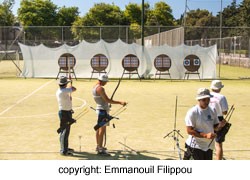
suitable to host training camps and preparations of all levels.
The Open Space facility at the Plantation site has a dimension of 120×85 meters, Danage (FITA) targets, a modern open space timer and ancillary equipment. It has a north direction, is fenced and secure and accessible by A.M.A.
There is a smaller outdoor training area at the Kallipateira Sports Center, which is available for short distances in a North-South direction of 50 meters and an East-West direction of 70 meters. For the distance of 18 meters, there is a small training area in the Scout Gym.
Shooting
For shooting there are the following facilities:
Laporte Hellas Clay Target Shooting RangeFive north-facing, ISSF-spec Olympic Skeet and Trap courts, non-Olympic Sporting Compact, English Sporting and America Trap with Lapotre electromechanical equipment, offerable free weapons, trainer and assistant.It has a refreshment room and WC.
Airgun Shooting Range
Located in the city of Rhodes, it is accessible by A.me.A. and includes modern electro-mechanical equipment of international standard RICA Austria 12-seater goal systems, electronic performance measurement system, comfortable athletes’ area, spectators’ area, excellent lighting, air conditioning, storage, WC and WC A.m.A.
Shooting Ranges of Practice Shooting
They are located in the Kalamonas area on the east side of the island, in the Municipal Unit of Petaloudos and have:
Horseback riding
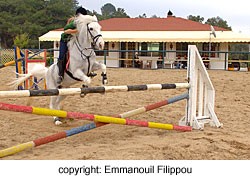
Horseback riding has beneficial properties for people with mental and intellectual disabilities. I collaborated with the riding club “Kadmos” and specialist therapists. The club has privately owned facilities in the area of Asgourou with a total area of 12 acres:
